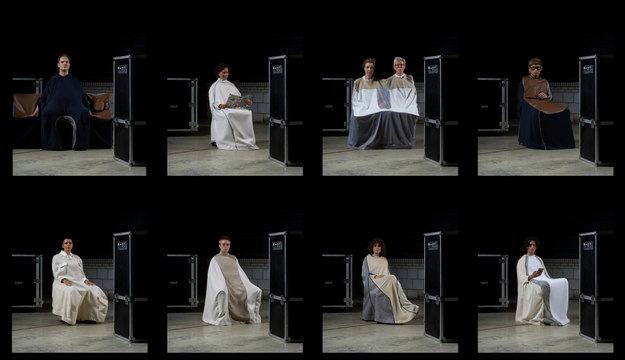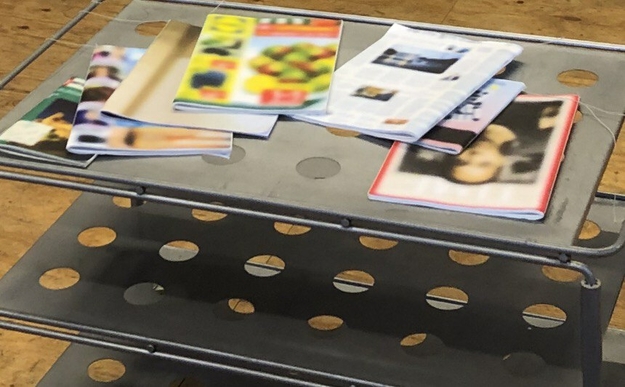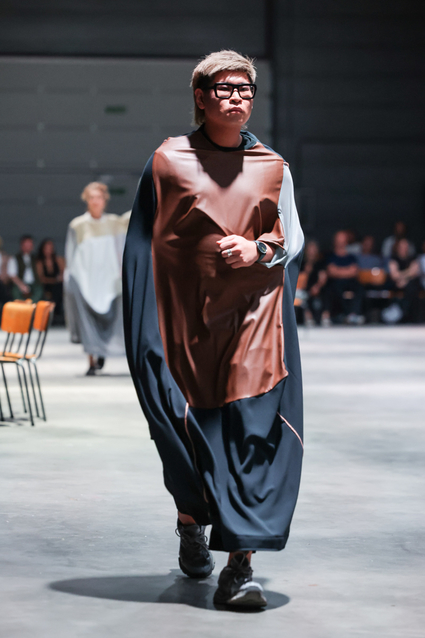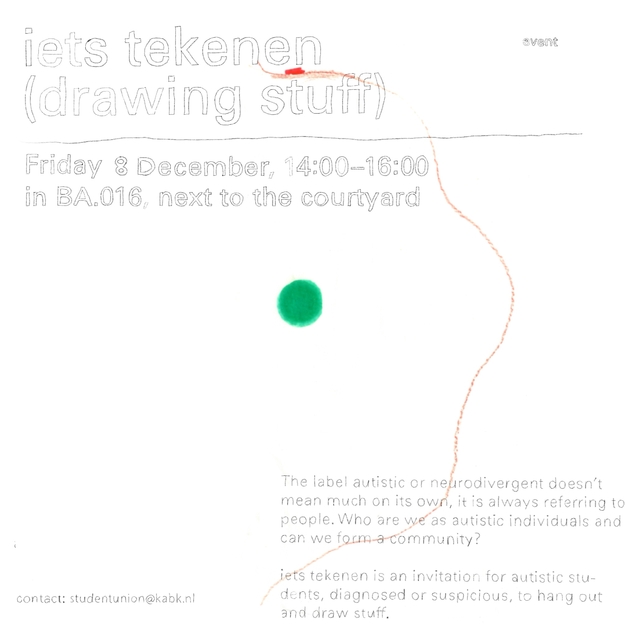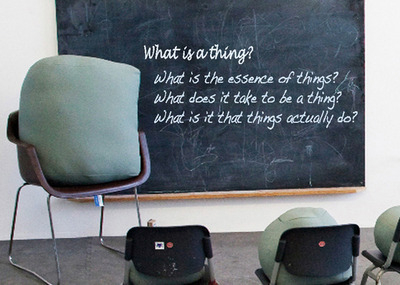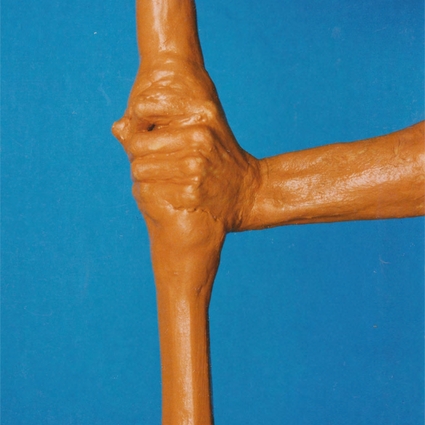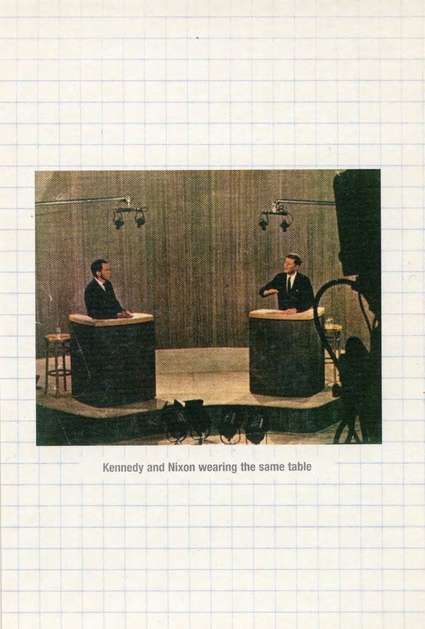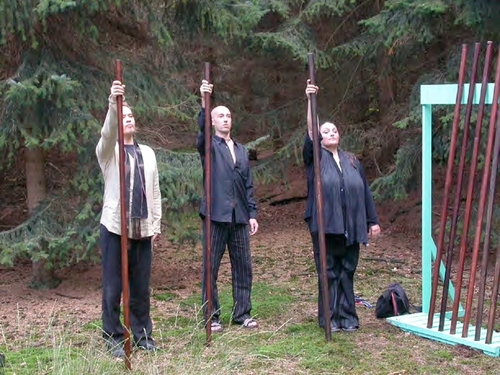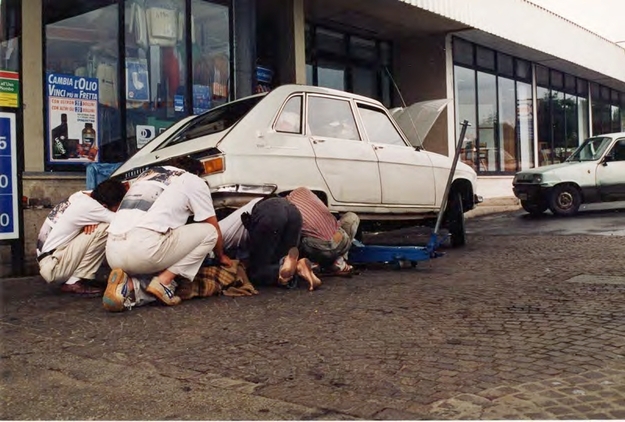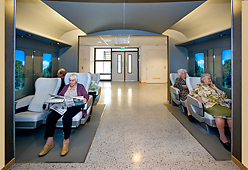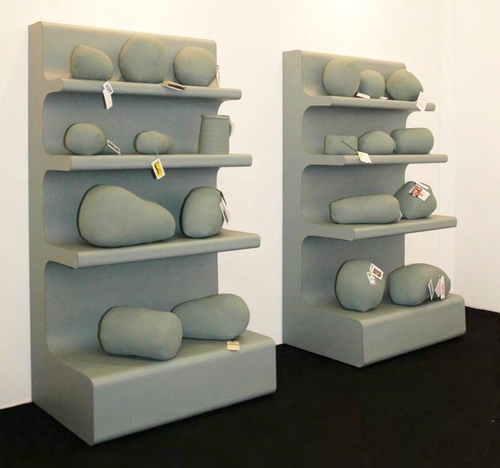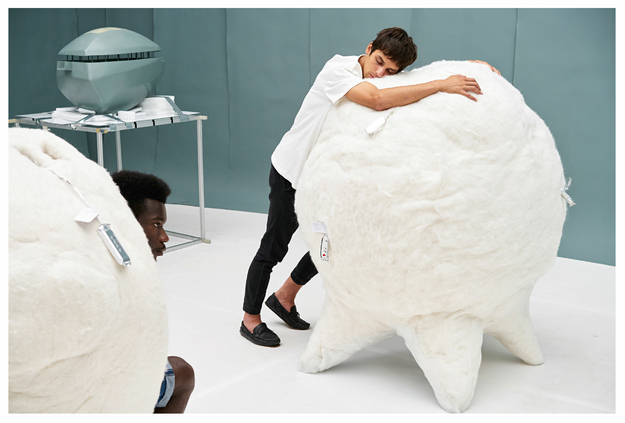Overview of the evening
First, Vera Lelie shared the process behind her project 'The Waiting Room', with which she graduated from the Rietveld fashion department in 2023 and which reflects on the relationship between people and the spaces they find themselves in. After the break, Yvonne Dröge-Wendel walked us through her career as an artist fascinated by the relationship between people and objects, arriving, in the end, at her work 'Moments in a Thing-Tank', which is currently on display at Mediamatic. Students from KABK in the Hague also introduced their new initiative for cultivating neurodivergent community at their school, 'iets tekenen', and we ended with a panel discussion featuring all the presenters in conversation with a very engaged audience.
Read on for a more detailed report!
Vera Lelie - The Waiting Room
'I made The Waiting Room my graduation project at Rietveld, because I was getting tested for ADHD during my graduation year and it kind of took over my creative space', Vera began her presentation.
Reflecting on the relationship between people and spaces, Vera realised that neurodivergent people are often placed in a very specific space throughout the process of getting treatment or a diagnosis: the waiting room. 'And I’ll be talking about how, in my experience, it’s not catered to neurodivergent people at all.', she added.
For her graduation show in the fashion department, Vera created a number of garments representing the archetypes found in the waiting room: 'The man-spreader who claims the seats next to them, the person who is checking the time, the person who’s reading the magazine or the person scrolling on their phone…'
By wearing these garments, visitors are invited to become part of the waiting room themselves.
During her presentation, however, Vera concentrated on her preliminary process of exploration and research around waiting rooms.
ChatGPT: 'I am the waiting room'
'Before this project I hadn’t been in many waiting rooms myself — I was often late to my appointments, but I also think I tried to avoid the waiting room as much as possible.', Vera admitted. 'This is why I first asked ChatGPT to describe it to me.'
In response, the AI transformed into a personified waiting room with a taste for the dramatic:
'I am the waiting room, a place of transition and anticipation. Every day I bear witness to the ebbs and flows of human emotions. My walls have observed the whispered conversations and silent tears of those who passed through my doors. […] I have seen the trials of human spirit in the face of adversity, and the power of hope in the darkest of moments — I am the waiting room.'
'I view AI and other technologies as tools that can support neurodivergent users. It allows me to ask questions and educate myself on things that I wouldn’t really do intuitively.', Vera reflected. 'ChatGPT helped me for when I was going to put my theory to the test.'
Visiting waiting rooms without an appointment
The way she decided to go ahead was by visiting waiting rooms without an appointment. 'I had one rule,' she explained: 'To experience the whole cycle of people, leaving only when all the people who were there when I came in had left.'
'At this point in the process I had been waiting for my first appointment for almost a year', she shared — 'And this is the same for most people who have gotten diagnosed, the minimal waiting time is probably three months. It's just a lot of waiting, on hold on the phone, waiting on waiting lists, in waiting rooms — which is so ironic, to put these people in spaces that don't cater to them or their needs and are so counterintuitive to the symptoms that they have.'
A guide to the waiting room
'This is why I decided to create a guide for all the people who, diagnosed or undiagnosed at the start of their process, will have to navigate the space of the waiting room.', Vera explained. At the same time, the guide works as an insight into the way neurodivergent people perceive and navigate spaces that can also help neurotypical people understand these experiences better.
She then walked us through six archetypal elements of the Waiting Room.
1. The Room
Our tour began by entering the room. 'As soon as you enter a room, you're being perceived.', Vera said. 'This is not such a daunting thing for everybody, but as a neurodivergent person it can be quite an intense feeling — it feels like everybody is looking at you, every step you take you are in their line of sight.'
Some precautions to feel more comfortable in this situation could include, as Vera listed, wearing headphones and/or bigger clothes that cover your body, as well as bringing entertainment to distract mind and hands.
'When referring to a space we often think of a room, but there’s also the sense of someone being in your space.', she added. 'It can be when someone is sitting too close to you or staring at you, which is often something you can’t avoid in waiting rooms since they are quite small and space efficient. But there are unwritten rules of course: you don’t sit next to someone when there are other spaces left, and you create your own space by listening to music or bringing other entertainment.'
The Waiting Room during museum night 2023 -
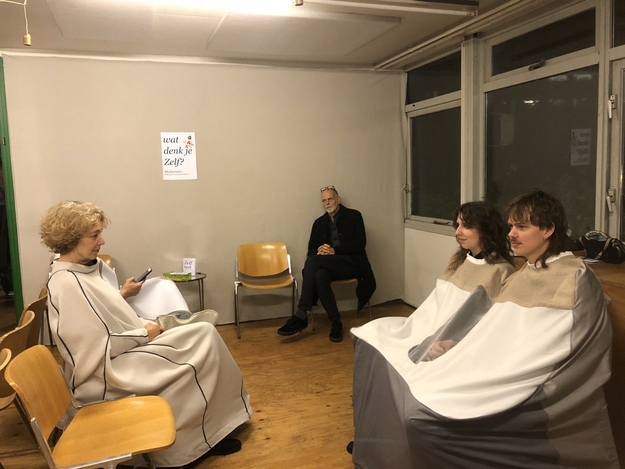
2. The reception desk
The next step in Vera’s guide was the reception desk. 'It’s the place where you identify yourself and prove your right to be in the waiting room. Of course this was harder for me because I didn’t have an appointment — but you probably won’t have this issue, unless you get the time and date wrong — which happens to the best of us, right?'
The reception desk represents the first obligation to interact with someone. Although this interaction should be quite straightforward — stating your name and the time of your appointment — as a neurodivergent person it can be more of a challenge. 'It's important to remember that the person behind the reception desk probably isn’t really paying attention to whether you’re saying things right or acting properly.', Vera assured us.
Since the reception desk is also where you prove your right to be in the room, it can be a place where you experience what Vera called 'belonging uncertainty'.
'It's when you feel ambiguity about whether or not you belong in a particular social group or environment.', she explained. 'This can be overcome by having structures or rules of engagement in place, creating a role for yourself in the context.'
3. Choosing a seat
She continued: 'Now that we are past the receptionist, it's time to choose a seat. This is a very important part of the process, because it decides who your audience will be and for whom you’ll be performing. Your chosen seat determines your view of the room and others’ view of you.' Another word for performing, in this context, is masking — concealing your neurodivergent behaviours. 'Of course I’m not telling you that you should mask when you’re in a waiting room, that’s up to you', Vera clarified. 'I just think we naturally do it when we are in a public space.'
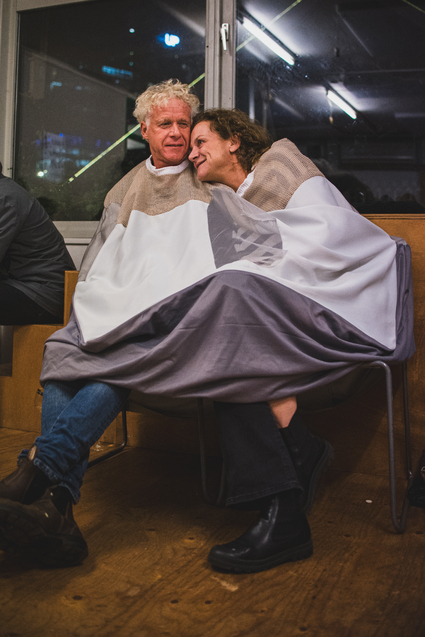
Entering a waiting room also involves entering a predetermined dynamic. 'There might be something that the whole room already knows, and you don’t yet.', Vera said. 'But when the next person arrives in the room, you’ll be part of that community that knows something already, and maybe that will give you a sense of belonging.'
She referred to assemblage theory, a philosophical approach for redistributing the capacity to act from an individual to a socio-material network of people, things, and narratives, arguing that this approach can be used to explain the ever-changing dynamic of the waiting room. 'Following assemblage theory the relationships within space are constantly in flux. The unwritten culture that is created in a waiting room is determined by the people in the space and can completely change when those people are gone.'
4. Entertainment
Once you are sitting in your self-assigned seat, you might become aware of the lack of entertainment and the fact that your hands don’t have anything to do.
Waiting is considered to be very boring, which is why there’s usually an array of entertainment in the form of magazines provided in the waiting room. “However, a magazine is flipped through quite easily and then you don’t have anything left to do.“, Vera said. 'This is why I always, at all times, bring entertainment with me. For me that’s a book, a notebook and a knitting project. For yourselves, I’d encourage you to find something that helps your hands and your mind stay busy.'
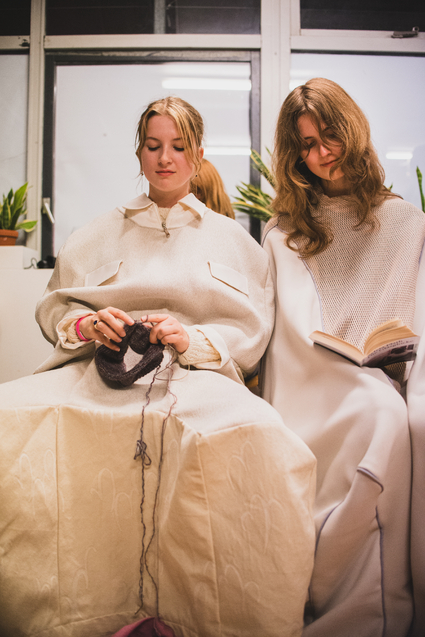
5. The clock
There will come a point at which you will wonder how long you have been waiting for. This is why waiting rooms provide a clock. Vera explained how the passing of time, represented by the clock, can feel very different to neurodivergent people: 'You can experience hyperfixation, where you are so focused on something that you forget to eat, drink, go to the bathroom… there’s also something called 'waiting mode', which means you are so much in anticipation of something happening at another point during the day that you can’t do anything else but wait for that event.'
The ways our society has agreed to indicate time in repeating cycles of minutes, hours, and days don’t fully represent what time can feel like to people, Vera argued. 'People often say that time goes slower while waiting but it can’t really go slower or faster if time is an abstract medium for you.'
6. The appointment
Finally, we reached the appointment, the moment your name is being called and once again you have to interact with someone and follow them through the lines of sight of everybody in the room. 'This can feel like you’re being put on the spot, but most people are probably just annoyed that it’s your turn before them.'
Conclusion: The waiting room as a medium
'This is where my guide ends. You’ll have to be on your own from now', Vera said to round off her presentation. 'But I want you to remember that the things I’ve talked about apply in a lot of spaces and not just the Waiting Room. In most spaces there are a lot of elements that neurodivergent people may come across which neurotypical people wouldn’t even think about.'
The most important thing, she reflected, is to ask about other peoples’ experiences and needs, and to try to imagine yourself in their shoes. Her tour of the waiting room allowed us to experience this kind of empathy. 'The waiting room for me encapsulates the experience of neurodivergent people, and I hope it worked as a medium to explain this experience to you.', she concluded.
Q&A
After this, we opened the floor to questions.
Materials
Someone asked about the inspiration behind the materials that make up Vera’s waiting room garments, and she answered: 'The materials I decided on are furniture fabrics that you would find in a waiting room. They are often very uncomfortable and scratchy, they also have a very specific colour palette that I think is supposed to feel welcoming or calming but is often kind of intense or disturbing — the waiting room has a very interesting aesthetic, and that’s what inspired me.'
How could waiting rooms be designed differently?
Then, a member of the livestream audience on Instagram jumped in with the question of how waiting rooms could be better designed with the needs of neurodivergent people in mind, and a lively discussion ensued.
Vera pointed out that there are no one-size-fits-all solutions, but that clear signs and structures would be helpful, to which several audience members expressed agreement.
Someone suggested a different colour scheme: 'All the waiting rooms I’ve been in have been three shades of grey and it feels like a prison, so I would say more colour!'
'No very bright lights!', someone else added, and another livestream viewer suggested incorporating space to stand and move around in the design of waiting rooms.
'A dedicated fidget-corner!', Mediamatic's director Willem Velthoven elaborated, and someone else chimed in: 'Or one of those exercise machines…'
Mediamatic’s programme manager Naomi van Dijck suggested handing out buzzers at the reception desk which would allow people to walk around freely until the buzzer goes off, calling them to the appointment. Artist Jenny Konrads agreed, adding that the buzzer would also be a good tool for startling you out of hyperfocus.
'There’s fantastic expertise in this room!', Willem noted. 'Let’s make a design team for waiting rooms!'
Is the best waiting room one you don’t need?
Filmmaker Or Shahaf voiced the reservation that all these measures might be self-defeating — 'It’s nice to have a good waiting room, but maybe a really good waiting room is one you don’t have to wait in for a long time.'
Vera agreed, adding: 'I asked ChatGPT at some point what the future of waiting rooms will be, and it said 'a system that’s effective enough that people don’t have to wait anymore.''
Finally, Willem thanked Vera for her presentation and insights — 'It’s a cool discovery that many people here are passionate about waiting rooms!' — and a/Artist co-curator Annelies Wina Doom invited the audience to try out Vera’s garments during the break.
The Waiting Room Modecollectie van Vera Lelie - Exhibition during Museumnacht 4 & 11 November 2023
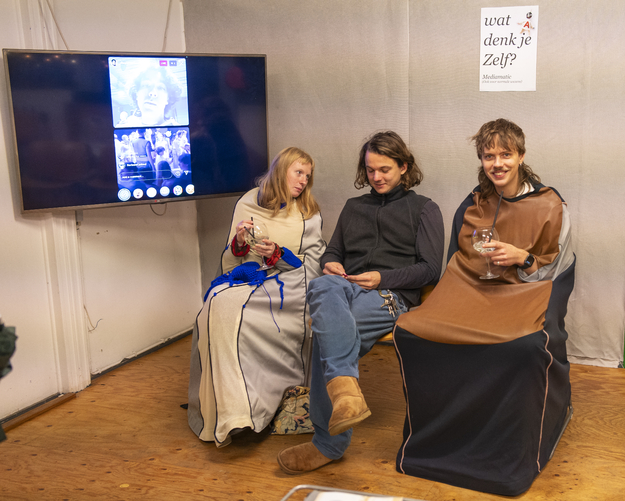
Iets tekenen
Before the break, students Elvira and Pum from KABK in the Hague briefly introduced their new initiative iets tekenen, which has neurodivergent students come together once a month (usually on the first Friday) to draw and talk.
'There’s no specific goal, it’s just a space where we can come together and talk while doing something at the same time.', Elvira said, and Pum added: 'Some people don’t draw and only speak and some people don’t speak and only draw — the jargon for this is parallel play, playing next to each other but not necessarily with each other.'
'So far it’s really working!', both of them were happy to tell us. After iets eten at HKU in Utrecht, iets tekenen is the second such initiative at an art school in the Netherlands aimed at bringing neurodivergent students together.
Yvonne Dröge Wendel: Human-object relations
After the break, Willem introduced our second speaker, Yvonne Dröge Wendel, who is also the head of the Fine Arts department at the Rietveld academy.
Yvonne walked us through a number of projects from her long career as an artist since the 1990s, which all play with the relations between people and things. 'I’ve been interested in that since I was a student', Yvonne said. 'I strongly believe that there’s no distinction between being materially engaged and socially engaged and I’m very interested in how we form one another as things and as human beings.'
Where does the human end and the object begin?
'The question for me has always been: where does a human start, where does a human end — for example, when you’re sitting on a chair, can you feel through the chair to the ground', Yvonne remembered. 'So I made a lot of works that are human-thing hybrids.'
'People sometimes say material things don’t matter to them, but when it comes to important occasions, the outfit of the room does matter. For example when they present the new presidential candidates on TV, they give each candidate exactly the same table, exactly the same microphone…'
Wooden sticks to train your emotions
Yvonne showed us a few snapshots from a period of work that revolved around wooden sticks. 'I worked a lot with wooden sticks that I took traveling. This is a stick I took to the Caribbean — a lot of the time I had a nice bag to carry my stick in, and people would ask me what I did with it. In response to the questions I would go and do exactly what they suggested, like fishing or cleaning…'
Travels with a stick - Project by Yvonne Dröge Wendel
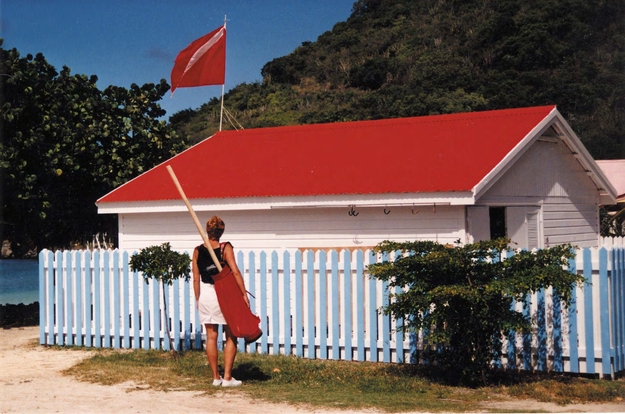
Another project involving wooden sticks came in the form of a 'fitness trail' like the ones one sometimes encounters along forest paths. Instead of your muscles, however, this fitness trail was meant to train your emotions by interacting with the sticks in different ways. 'When you hold a stick like this, you start feeling proud', Yvonne explained, demonstrating the gesture. 'But when you hold it like this, you immediately get the feeling of cleaning the kitchen floor. The emotions don’t come only from the thing or from the human, but from connecting with one another in a specific way.'
La Benedizione della Macchina
Next, Yvonne told us about how, in 1994, she drove her brother’s twenty-year old Renault 16 TL to Rome to have it blessed by the Pope. She created a documentation of the journey, which was defined by much car trouble, and went on to win the 1994 Prix de Rome. 'The journey was about the fact that a car can completely absorb your feelings. This beautiful 'Grand Tour' to Rome just vanishes and you just care about the car, because there was always something wrong with it.'
Yvonne also created a collection of maps from her journey, which were later displayed inside the renault that was half built into the wall, so that visitors had to climb inside the car to look at the maps. 'Being in a car activates people in a specific way', Yvonne said and showed us a picture of the sponsors of the Prix de Rome. 'Outside the car they were really stiff business men, but the minute they sat in the car they started talking about their youth — within seconds they enthusiastically behaved like boys. That’s also something an object can do.'
Honeymoon with a cabinet
Yvonne also showed us images from her wedding ceremony and honeymoon in Portugal with the cabinet Wendel, which she married in 1992 and whose name she has adopted since then. 'This is the part I married, the lower part.', she pointed out. 'And this upper part was the witness, of course.'
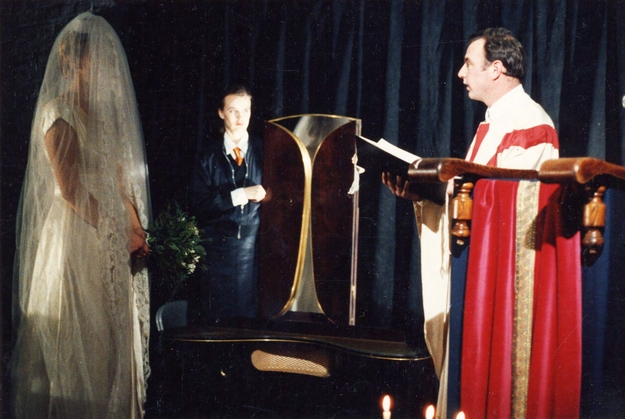
'At the time of the wedding, I was a student and I just thought okay, we’ll do that.', Yvonne remembered. 'I thought it was a one-week project, but it lasted for such a long time… I’m still quite happy with the results, how the discussion around the wedding with an object went and how it influenced my practice as a whole.'
Alzheimer and the right to do nothing
Yvonne then introduced us to a project from 2008 reminiscent of Vera’s Waiting Room. Together with a colleague she had been approached by an Alzheimer nursing home in Delft and asked to research and design something that would help the patients feel more at ease in the space.
'You can’t really work with words, because these patients forget everything immediately', Yvonne explained the difficulty of the task — 'They sit in the common room all day and become restless and annoyed with each other. The people working in the clinic try to engage the patients in activities, so every two minutes a nurse comes and asks if they’d like to do something.' At one point, a patient exclaimed: 'I have a right to do nothing, I just want to sit here and enjoy myself in peace.' Inspired by this, Yvonne and her colleague Lino Helling researched the nicest possible way to do nothing. They arrived at the conclusion that one is most comfortable doing nothing while sitting in a train, watching the world go by outside the window to get a sense of movement and action.
Thus, the artists then set out to design a virtual train experience for the Alzheimer patients. 'The world' in this case were images of the empty landscape of Friesland in a one hour loop, which patients could watch while drinking a cup of tea in a refashioned high tech train coupe. The installation was counted as a great success by patients and experts alike. 'We don’t exactly know why, but people really like to sit there, also for long periods of time.', Yvonne said. 'One doctor speculated that it was something about the slow movement, about always positioning yourself in the here and now. That’s also what fidgeting and those kinds of activities are about.'
Items store
Another project from 2008 was titled 'Item store'. Fascinated by the idea of objects that have hardly any qualities, Yvonne devised cupboards where the foreground was meant to look exactly like the background, stocked with indistinct items. The items had slightly different shapes but no apparent purpose, and only really differed in what was written on their labels. 'Somehow this was really attractive to people, precisely because it’s not something. People started buying the items and wanting specific ones, with specific labels, even though they were basically all the same, made from the same material.'
In connection to this, Yvonne also reflected on the life span of objects: 'I think it would be good if we didn’t throw an object away but only change its surface or its label, so it becomes a new thing. But unfortunately it doesn’t work like that, and most objects still die at some point.'
Bruno Latour and active collectives
Digging deeper into the philosophy behind human-object relationships, Yvonne discovered the writings of Bruno Latour. 'He includes and talks a lot about the nonhumans, which was a big discovery and relief for me, because before that the spectrum of how philosophy looks at objects was often limited to Heidegger. Latour opened up a whole new way of thinking about nonhumans, including things.'
She continued to describe her philosophical beliefs: 'I don’t believe in post-humanism. I believe that there are humans and they are always different. Once you try to define what a thing is, it starts behaving in a certain way. I don’t believe in making an effort to define the essence of a thing.'
Instead, she referred to the idea of active collectives, similar to that of assemblage theory which Vera had mentioned earlier with regard to waiting room dynamics. 'Humans, objects, plants and microbes form active collectives, and I think it would be fantastic if we could see and grasp the complexity of these collectives and find the right words for them.'
In 2009, Yvonne, together with Lino Henning, created the project and book Architecture of Interaction. 'That book really included some guidelines on how to look at collaborative practices.', she told us. 'But it was written only from a human point of view, looking at collaboration among humans. What I’m trying to do at the moment is to re-write it to also include collaborations between humans and more-than-human beings.'
Thing-Tank
With that, we arrived in the present, and Yvonne’s current project of the Thing-Tank. 'It’s meant to be a room you can enter to think about things and get fantastic ideas for your own art projects.' She described the different objects in the Thing-Tank: 'Each one would behave differently, they look the same but do different things. One is magnetic, another one would roll away, one starts massaging you — they all do unexpected things which you can’t see or predict from the outside.'
The objects on display in the Sluisdeurenloods at Mediamatic are prototypes for this future interactive Thing-Tank furniture.
Q&A — Beyond hammers and nails
After applauding Yvonne, we moved on to the Q&A. Willem began with an observation about the openness and subtlety of Yvonne’s work:
'There’s this very common saying that when you have a hammer everything starts looking like a nail. But your work is much more open and receptive and less directive than that hammer.'
What’s your relationship like with your own objects?
Next, someone from the audience inquired about Yvonne’s relationship to her own various objects, and how it is informed by her views on appreciating and caring for objects.
In response, Yvonne remarked upon the arrogance underlying statements such as “I’m not interested in objects“ — 'Our whole world is getting destroyed because of all this buying and throwing away, what I call one-night-stands with objects. But it’s really important what kinds of objects you use and how much importance you give them. For example, in the old days, the chairman was the only person in the room who had a chair, and that really changes the conversation. It changes your behaviour and attitude the minute you sit opposite each other — like in the UK parliament where you’re opposed to one another and you can’t move. The furniture and objects in a room already determine 50% of the interactions we have, so it’s really important that people change their attitude towards things. Maybe in the future the rules will change and thirty years from now a person is given one single chair when they are born, and that’s it. I just love the idea of never throwing a thing away.'
Can relationships with objects change?
Adding to this, another guest asked whether relationships to objects can change when you’ve had them for such a long time.
Yvonne shared the story of her bicycle: 'I got it from my father when I was seven years old. I always loved it, but back then it was too big, and now suddenly everyone is going faster than me with electric bikes, so I get angry at my bike. I’ve had it for fifty years, but I’m seriously thinking about getting rid of it now.'
She also asserted that attitudes towards objects should transcend our personal feelings. “It’s important not to reduce it to that, but to be able to see what things actually do. Sitting with a smartphone all day changes our posture, those kinds of things. But of course, I also buy stuff and I love buying stuff…“
The difference however, Yvonne’s daughter remarked from the audience, is that she never throws anything away.
Applied Latourian philosophy?
Artist Victor Evink asked about Yvonne’s interest in Bruno Latour’s writing, and how the Latourian ideas about thing-ness could come to be more practically applied in design and society at large.
Yvonne began by expressing her admiration for Latour — 'First of all I could kiss his feet, I think he’s really brilliant. He changed so much, and gave people a refreshing approach and more freedom — you can talk about ghosts now, about all sorts of non-human entities… I see a lot of his ideas reflected in Mediamatic’s programme as well. Of course he was a sociologist and not an artist, and I don’t agree with everything he said, but I especially like all his writing between 2004 and 2012. I think that new materialism and various new approaches got encouraged by Latour.'
With regard to these ideas' wider impact beyond art world and academy, she added:
'I think it’s really difficult to see things differently. It really takes years for us to start admiring things as active — we also lack the right language, so I think there is still a lot of work to do. A lot of scholars and artists are working on it but it’s difficult and every little step is important.'
Or added that Latourian and new materialist ideas are not in fact new, but often based on Indigenous practices and knowledge around the vividness of things. 'It’s not that it’s a new thing or doesn’t exist beyond the academy, just not so much around here.' Yvonne agreed, with the reservation that it was only through Latour and following philosophers that such ideas became to be taken seriously in art and academia in the Netherlands and the West more generally.
Panel discussion
To round off the evening, we hosted a sort of panel discussion during which Yvonne, Vera, Pum, Elvira and the audience members shared their insights and ideas on the topic of neurodivergence in art schools.
From thinking about an initiative like iets eten or iets tekenen for the Rietveld academy, the discussion moved on to the more general topic of providing support to students with very diverse needs, and how access to this support can sometimes be complicated due to privacy concerns.
Vera shared that while sharing her diagnosis and needs with her teachers was helpful, what she was really missing during this time was representation — 'I was really wondering what it meant that I was neurodivergent, did it mean that I’m doomed? If I don’t have representation of people doing well in art school, am I even going to graduate, am I able to make it through assessment, all these things.'
Yvonne shared that, as head of the Fine Arts department at Rietveld, she has of course thought this through, but the diversity among students has made it difficult to come up with concrete initiatives. 'How do you make categories, how can you create a specific group?', she asked, a question we passed on to Pum and Elvira, who said: 'In our group, all students who are in need of neurodivergent community are welcome. One of the most interesting things during the sessions is talking about how we are all different from each other.' Renske, student representative of iets eten at HKU, also jumped in to describe the process at their school, and the positive impact the iets eten group has had on its members.
Educating teachers
Another topic of discussion was the education of teachers to better support neurodivergent students, be it by pointing them to existing student groups or providing clearer assignment guidelines. Elvira pointed out that neurodivergent students may use tools like ChatGPT to approximate the 'normal' standards for, for example, sending emails, to which Yvonne added that teachers usually try to 'help students get to normal instead of changing the normal' as well, which is why she considers teachers' trainings to be important. Vera added that a generational difference might play into this as well: Many of the teachers in arts schools might themselves be undiagnosed neurodivergent people who have had to deal with the same difficulties that young students are now starting to speak out about. This is why many teachers, upon being approached by students voicing their needs, might say 'Yeah, but that’s normal.'
The blessing and the curse of labels
Finally, there was a lively discussion about the role of labels like autistic or neurodivergent, and how they can be both alienating and stigmatising and necessary for finding one’s community and understanding one’s needs at the same time.
With that, the evening came to a close, and Willem thanked all presenters and the audience for the interesting talks and good questions.
If you enjoyed this, you might also like:
On relating to spaces:
Shields and Shelter, roundtable discussion about Kristin Maurer's work on architectural anxiety
On relating to objects:
For the Love of the Object: Design in the Opposition, roundtable discussion about Marjanne van Helvert's 'dirty design' practice
On neurodivergence in art education:
Creating neurodivergent community in art education
Tools for flourishing in art education (and life)
Original event information
Tickets (inc. vegan meal + drink):
Student/artist/Stadpas: €9.80
Full price: €14.00
The event was hosted by the A/artist program team, a project at Mediamatic which platforms artists and designers who identify as/with the ASD or ADD spectrums. The program started in 2021, focusing on hosting regular roundtable sessions and publishing articles generated through these discussions.
If you have any questions, please feel free to contact a.artist@mediamatic.nl!
